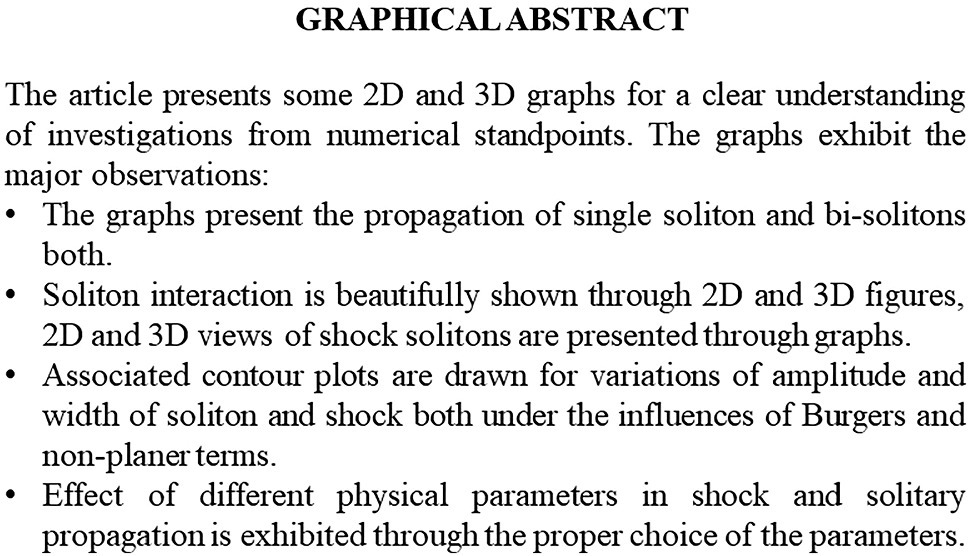https://doi.org/10.1140/epjd/s10053-023-00676-8
Regular Article – Nonlinear Dynamics
Dust ion acoustic bi-soliton, soliton, and shock waves in unmagnetized plasma with Kaniadakis-distributed electrons in planar and nonplanar geometry
1
Department of Mathematics, Mathabhanga College, 736164, Cooch Behar, West Bengal, India
2
Department of Mathematics, Cooch Behar Panchanan Barma University, 736101, Cooch Behar, India
3
Siksha Bhavana, Visva-Bharati, 731235, Santiniketan, India
Received:
29
August
2022
Accepted:
16
May
2023
Published online:
6
June
2023
This article presents bi-soliton, soliton, and shock solutions for the ion-acoustic wave (IAW) propagating in an unmagnetized nonplanar dusty plasma containing cold ions, neutral particles, and the electrons obeying  -deformed Kaniadakis distribution. Applying the reductive perturbation method (RPM) to the basic equations, the nonplanar KdV–Burger (KdVB) equation is derived. It is found that there is a parametric domain for which the nonlinear coefficient vanishes, and naturally, the infinite divergence of the amplitude of the soliton arises. To describe the dynamic features of the wave quantities at or near the parametric domain, the nonplanar modified KdV–Burger (mKdVB) equation is constructed. The dissipation effect in the viscous plasma is expressed in the current study by a Burgers term, and the weighted residual method (WRM) is used to produce a solitary-type progressive wave solution for very small values of the Burgers term. Hirota’s bilinear formalism is employed for finding the multi-soliton solutions for the nonplanar mKdV system. However, the strong dissipation may cause the origination of a shock solution. An approximate analytical solution is also explored by means of WRM, through which the evolution of shock waves is determined. Finally, under the variation of various physical parameters, the evolution of different types of wave quantities is numerically examined.
-deformed Kaniadakis distribution. Applying the reductive perturbation method (RPM) to the basic equations, the nonplanar KdV–Burger (KdVB) equation is derived. It is found that there is a parametric domain for which the nonlinear coefficient vanishes, and naturally, the infinite divergence of the amplitude of the soliton arises. To describe the dynamic features of the wave quantities at or near the parametric domain, the nonplanar modified KdV–Burger (mKdVB) equation is constructed. The dissipation effect in the viscous plasma is expressed in the current study by a Burgers term, and the weighted residual method (WRM) is used to produce a solitary-type progressive wave solution for very small values of the Burgers term. Hirota’s bilinear formalism is employed for finding the multi-soliton solutions for the nonplanar mKdV system. However, the strong dissipation may cause the origination of a shock solution. An approximate analytical solution is also explored by means of WRM, through which the evolution of shock waves is determined. Finally, under the variation of various physical parameters, the evolution of different types of wave quantities is numerically examined.
Santanu Raut, Kajal Kumar Mondal and Prasanta Chatterjee have contributed equally to this work.
Copyright comment Springer Nature or its licensor (e.g. a society or other partner) holds exclusive rights to this article under a publishing agreement with the author(s) or other rightsholder(s); author self-archiving of the accepted manuscript version of this article is solely governed by the terms of such publishing agreement and applicable law.
© The Author(s), under exclusive licence to EDP Sciences, SIF and Springer-Verlag GmbH Germany, part of Springer Nature 2023. Springer Nature or its licensor (e.g. a society or other partner) holds exclusive rights to this article under a publishing agreement with the author(s) or other rightsholder(s); author self-archiving of the accepted manuscript version of this article is solely governed by the terms of such publishing agreement and applicable law.





